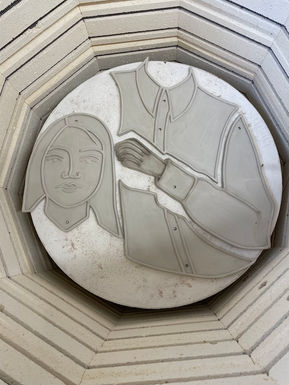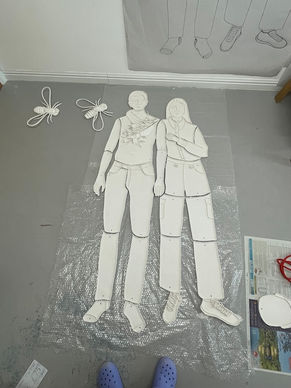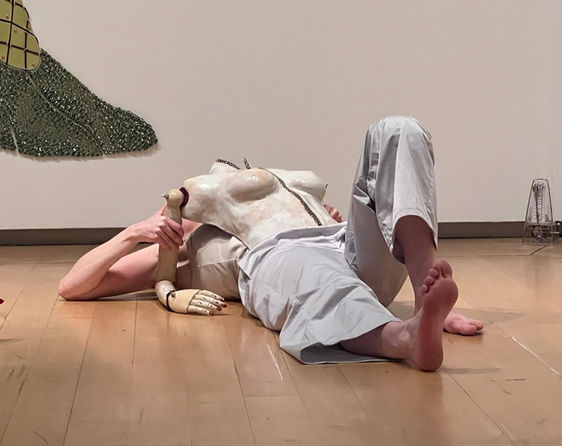Body, Sound and Movement
Interview with Paloma Proudfoot

Paloma Proudfoot, Photo: Jenny Lewis
It was Paloma Proudfoot’s distinctive artistic approach that first caught the attention of Annette and Rainer Stadler and immediately fascinated them. They first encountered the young British artist’s work in 2020 during Various Others in Munich, when the Berlin-based gallery Soy Capitán was hosted by Jo van de Loo.
Proudfoot’s practice combines sculpture, ceramics, textiles, and performance. The starting point of her work is often the human body – not only as a physical form, but also as a vessel of history, identity, and memory. One might describe Proudfoot’s practice as a form of painting with ceramics: she tells stories and lends the material a new, expressive dimension. She is particularly interested in the transitions between body and clothing, sculpture and movement, individual and collective experience. Her works are created both individually in the studio and collectively, such as in performances with choreographer Aniela Piasecka.
In conversation, Paloma Proudfoot shares insights into her working process, her fascination with traditional craft techniques, and her current research into sound, mourning, and storytelling traditions.
You were recently in Milan, where you took part in a residency at the Fonderia Artistica Battaglia and worked with bronze for the first time. What was the biggest difference for you in working with bronze compared to clay – technically, emotionally, or in terms of the meanings the material brings with it?
At the foundry I was sculpting with wax, from which the bronze pieces are cast, which was quite similar to working with clay in many ways. Wax is malleable like clay, and was really pleasing to work with because it holds all the impressions you make in it, even after being cast in bronze you can see my fingerprints in the metal. The wax is less temperamental than clay though and holds its shape more reliably, so I could create more ambitious shapes that would have been too fragile in clay. I thought I would have to follow lots of rules when learning this new process, but I found it very freeing in the end!
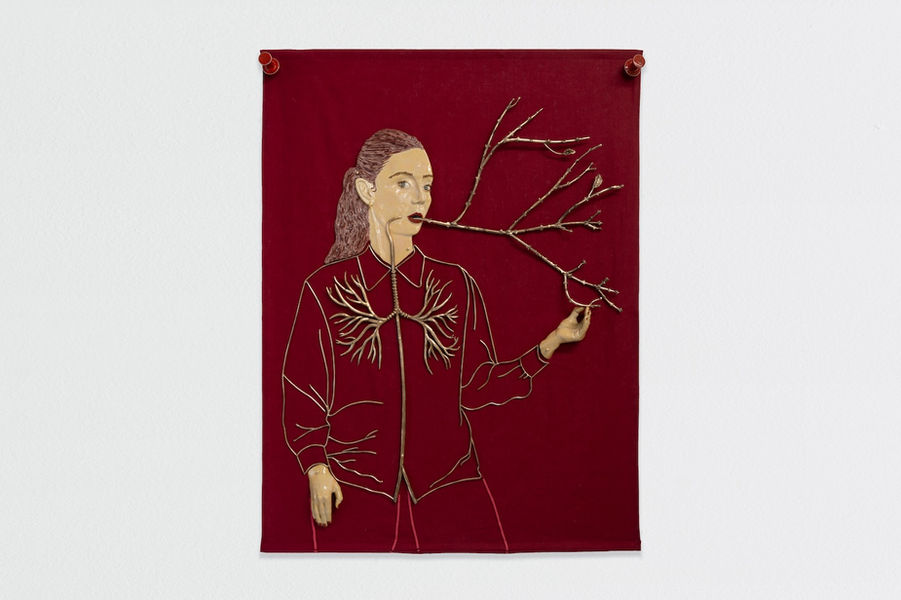
Paloma Proudfoot, Soundbleed, 2025, Glazed ceramic, bronze, linen, cord, metal fixings, 102.5 x 136 x 7.5 cm, Photo: Reliant Imaging
This work was created during the residency at Fonderia Artistica Battaglia. It is not part of the Stadler Collection.
Your first creative experiences were in sewing. Does that early, intuitive work with fabrics and patterns still play a role in how you approach sculpture today?
Yes definitely, I draw on pattern making a lot in my work, particularly the way the body is segmented and made into flat patterns before it is reformed and augmented in clay. I use this approach for practical reasons, so that each section can fit into my kiln, but it also guides the work conceptually too. In this dissecting and mapping of the body I draw parallels to anatomy, often blurring cloth and skin in my ceramic works. I’m hoping to bring these different ways of viewing the body together: the mathematical approach of pattern cutting, the scientific dissection of the body, and a more emotional register.
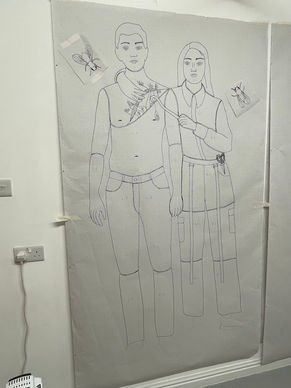

Work in progress: Paloma Proudfoot, Behind my flesh, 2023, Photos: Paloma Proudfoot |
Paloma Proudfoot, Behind my flesh, 2023, Glazed ceramic, embroidered gauze, metal, wall painting, bolts, 217 x 158 x 16 cm, Photo: Roman März
How do you begin a new work? Do you read a lot beforehand, observe, have conversations, or do pieces also emerge intuitively, from a physical process?
It’s usually a mix of lots of different influences, but I normally start with reading and going to see museums or researching a historical interest. I’ll have a group of ideas floating around in my head and get a feeling that there are connections to be made between different influences. It’s through drawing and sketches that I make sense of how these threads will come together and what expression it will have in my work. I’m always impatient to start on the sculpture, but I try to do as much drawing as I can because it allows for unexpected ideas to emerge.
Your works are filled with objects that seem to carry stories. Some appear repeatedly, like the needle. How do such symbols find their way to you? And when do you know that you want to work with them?
There are certain reoccurring symbols or motifs in my work that I come back to a lot, like scissors or needles because they bridge my different ongoing interests in anatomy, dissection, and dressmaking. These tools become a way to connect and blur these influences in my work, and are often depicted as means of disassembling or reconstituting the body in different ways. Actions of cutting open and mending often reappear as a way to disrupt the idea of the body as a single complete entity, revealing the open borders and fragility of the figures shown.
Your work often explores the body, not just as a physical object, but as a carrier of history, identity, and memory. What draws you to this theme again and again?
I’m fascinated with how we experience the world through many different lenses at once,the body is at once an intensely personal carrier of history, identity and experience as you say, but at a different scale it is embedded in worldwide ecosystems, where we are indistinguishable as an individual. My work keeps coming back to the dilemma of how you might bridge and acknowledge those perspectives at once, exploring individual expression through clothing, demeanor and actions, but also interrupting or unravelling the neat borders of the figures I portray.

Paloma Proudfoot, The Archivist (II), 2025, Glazed ceramic, cord, linen, metal bolts, 131 x 84 x 3 cm, Photo: Giovanni Canova
What does a typical day in the studio look like for you? Are there certain rhythms or routines that help you focus?
I usually try to keep office hours and I come to the studio almost everyday. The ceramics are like a needy garden, they require tending to and a lot of attention to make sure they don’t dry out too quickly and crack, so I always have a few things I’m keeping track of at once. I work so much better in the morning, so I do all my planning and problem solving then, usually with radio or in silence if I’m thinking something through. In the afternoon I do more straight-forward tasks so that I can go into autopilot mode and listen to music or a podcast at the same time. At the moment I listen to tennis commentary though, which I find very relaxing!
You don't just work alone, but also collectively, for example, with Aniela Piasecka, with whom you do performances. What does working together mean to you, and how does it differ from working alone in the studio?
Working collaboratively is really important to my work, in sharing ideas and finding different expressions for ideas I wouldn’t have otherwise thought of. My work almost always relates to the body in some ways, so it's amazing to work with Aniela who comes from a choreography background and is similarly focussed on the body and the stories it can tell but from a very different perspective. Aside from work, we are also friends, which is invaluable to have that sort of connection and support in both art and life.
Is there a dialogue between your performative work and your sculptural practice, or do you consciously keep the two separate?
Yes they are very closely entwined. The most recent performance I made with Aniela was created in tandem with the sculpture Lay Figure. It was choreographed with and around the work, a ceramic articulated mannequin. Aniela wore the ceramic mannequin as if a second body, echoing and amplifying her subtle movements. Aniela also wore costumes I created for the piece, which became part of the installation outside of the performance. Sometimes it’s more subtle connections, but I’m always looking for ways to create a sense of movement and performance in my work, even when working on my solo practice.
Paloma Proudfoot, Lay Figure, 2024, Glazed ceramic and metal fixings, 73 x 51 x 20 cm, Photo: Reliant Imaging | Aniela Piasecka, Preview Performance with Lay Figure at The Lowry, Salford 2025
Are there any themes that are particularly preoccupying you at the moment, perhaps even ones for which you haven't yet found the right form?
I’m particularly interested in sound and the gendered histories of gossip, storytelling and funereal laments at the moment. I’ve been on a deep dive into writing about feminist experimental music, ancient mourning traditions and celtic ‘keeners’. At the moment I’m finding ways to connect these different histories, and to visualise sound outside of the obvious sound-wave projections.
And when you look to the future: Is there a place, a new material, or a project that you dream of?
I have an exhibition in October at The Approach in London so at the moment I’m focussing on that and exploring some of the new research interests above, as well as some new works incorporating bronze and ceramics together. Aniela and I are also working on a new version of the piece we made for The Lowry for an exhibition next year at Collective in Edinburgh. I’m excited to continue exploring ideas of ventriloquism and movement with mannequins with them.

Paloma Proudfoot, Gardening, 2024, glazed ceramic, silk, metal srews, 164 x 500 x 10 cm, Photo: Nicolas Brasseur
Interview by Sophie Azzilonna
July 2025




